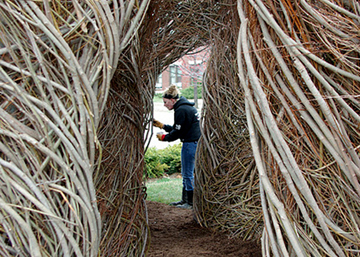Art and science combine in organic sculpture

Sidewinder," a sculpture built out of willow and red maple saplings by visiting artist Patrick Dougherty in collaboration with Purdue students, stands near the southwest corner of Pao Hall. (Photo by Michal Hathaway)
Five months after installation on the lawn next to Pao Hall, the organic sculpture "Sidewinder" is proving that art and science can, literally, be hybridized to produce innovative growth.
The sculpture -- built out of willow and red maple saplings by visiting artist Patrick Dougherty in collaboration with students from landscape architecture professor Ann Hildner's Plants, Landscape and Art class -- is sprouting new shoots.
Constructed over a 25-day period in March 2011, the 15-foot-high sculpture has become a favorite of the campus community and those who visit. Its curving, curling and twisted shape beckons to visitors, inviting them in to take a walk through the art piece and explore the unique tunnel-like spaces formed by the saplings.
"Sidewinder" is the product of an innovative interdisciplinary class offered last spring that combined art and science and was co-taught by Ann Hildner, assistant professor of landscape architecture, and Steve Visser, professor of performing and visual arts. The project is documented in "Stickworks," an exhibit opening Monday (Aug. 29) at the Robert L. Ringel Gallery in Purdue Memorial Union. The show features photographs, sketches, and models of many previous works by Dougherty with additional video and photographs describing the construction of "Sidewinder." It runs through Dec. 4.
Some 30 students from fine arts and horticulture and landscape architecture worked alongside Dougherty to craft the piece. Dinner and discussions with the artist helped further immerse the class in the process and the broader concepts of plants, landscape and art. The experience gave them a rare opportunity to contribute to a work of art that is expected to stand on campus for two years or more before naturally degrading. It was a rare opportunity for plant scientists to work alongside the more design-oriented landscape architecture and fine arts students.
"Landscape architecture shapes space. Horticulturists work with plant materials, and artists create expressive pieces that are site-responsive," Hildner says of the interconnection between art and science in the class.
Dougherty, brought to campus from North Carolina with funds from the Florence H. Lonsford Fund and the Bookwalter Fund, is known internationally for his Stickworks creations. Each work is crafted from naturally malleable saplings and responds in some way to its setting. For the Purdue project, Dougherty took his inspiration from the serpentine forms built in the Midwest by ancient Indians.
Dougherty defined the project as being as much about art and artistic expression as it was about building community. For Quinn Thomson, a fine arts and horticulture major who is fascinated with the intersection of art and the natural world in urban settings, it responded to both a physical and disciplinary interest in collaboration.
"The experience was a completely dynamic and unique offering that encouraged conversational collaboration, design input, social interaction, physical labor, and open-mindedness," he says. "The best part of it all? Physically experiencing your own work being produced."
![]() Photo gallery at https://cla.purdue.edu/think/pages/2011/sidewinder_gallery.html
Photo gallery at https://cla.purdue.edu/think/pages/2011/sidewinder_gallery.html
